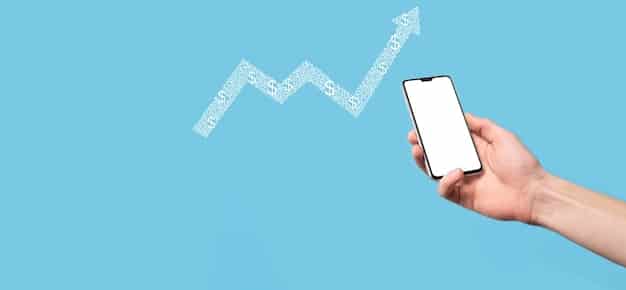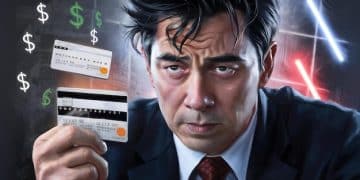Master Responsible Credit Card Use & Avoid Debt

Mastering credit card use involves strategic financial planning and disciplined spending to leverage benefits while systematically avoiding the pitfalls of accumulating unmanageable debt.
In today’s economy, understanding how to use credit cards responsibly and avoid debt is more crucial than ever. For many, credit cards are a convenient financial tool, offering flexibility and various rewards. However, without a clear strategy, they can quickly become a source of significant financial strain. This article explores practical approaches and key principles to help you harness the power of credit cards without falling into the debt trap.
Understanding the Power and Peril of Credit Cards
Credit cards are not inherently bad; they are sophisticated financial instruments that, when used wisely, can offer substantial benefits. They provide a convenient payment method, build a credit history, and often come with enticing rewards like cash back, travel points, or purchase protection. The “peril” arises when their use deviates from a disciplined approach, leading to overspending and accumulating high-interest debt.
Many individuals fall into debt simply because they view credit cards as an extension of their income rather than a short-term loan. This fundamental misunderstanding, coupled with a lack of budgeting and awareness of interest rates, forms the bedrock of most credit card debt issues.
The Dual Nature: Benefits and Risks
Credit cards offer a range of advantages when managed correctly. These include:
- Convenience and Security: Easy payments, both online and in-store, with fraud protection.
- Building Credit History: Essential for mortgages, car loans, and even some job applications.
- Rewards and Perks: Cash back, travel miles, extended warranties, and insurance benefits.
- Financial Emergency Fund: A short-term safety net for unexpected expenses.
Conversely, the risks are significant and often overlooked:
- High-Interest Rates: Annual Percentage Rates (APRs) can range from 15% to over 25%, making debt accumulation rapid.
- Minimum Payments Trap: Paying only the minimum can extend debt repayment for years and significantly increase total cost.
- Impact on Credit Score: Late payments, high utilization, and defaults can severely damage your credit rating.
- Impulse Spending: The ease of use can encourage purchases beyond one’s means.
Responsible usage means understanding this dual nature and always prioritizing the avoidance of debt. It begins with acknowledging that a credit card is a borrowed sum, not an increase in your disposable income, and should ideally be repaid in full each billing cycle.
Ultimately, a credit card should be a tool that enhances your financial well-being, not a burden. By grasping its mechanics and potential pitfalls, you lay the groundwork for responsible use and the avoidance of cumbersome debt.
Establishing a Solid Financial Foundation for Credit Card Use
Before even considering opening a credit card or if you already have one, establishing a robust financial foundation is paramount. This involves setting up a budget, understanding your cash flow, and building an emergency fund. These steps are not just theoretical; they are practical safeguards against falling into credit card debt.
A personal budget serves as your financial roadmap. It details your income and expenses, allowing you to see where your money goes. Without a budget, it’s easy to overspend unknowingly, leading to reliance on credit cards for everyday needs rather than planned expenses or emergencies.
Budgeting and Cash Flow Management
Start by tracking all your income and expenses for at least a month. Categorize spending to identify areas where you can cut back. Popular budgeting methods include the 50/30/20 rule (50% for needs, 30% for wants, 20% for savings/debt repayment) or zero-based budgeting, where every dollar is allocated. The goal is to ensure your income consistently exceeds your expenses, leaving room for savings and debt repayment.
Understanding your cash flow means knowing exactly how much money you have readily available at any given time. This helps you determine if you can afford to pay off your credit card balance in full each month. If your cash flow is consistently tight, it’s a red flag that you’re at high risk of accumulating debt.
Building an Emergency Fund
An emergency fund is a crucial buffer. Life is unpredictable; car repairs, medical emergencies, or job loss can strike at any time. Without an emergency fund, these unplanned expenses often lead people to turn to credit cards, quickly accumulating high-interest debt. Aim to save at least three to six months’ worth of living expenses in an easily accessible savings account.
This fund acts as your first line of defense. Instead of putting a sudden, large expense on a credit card and paying interest, you can tap into your emergency savings. Once the immediate crisis is over, you can then focus on replenishing the fund without the added burden of credit card debt.
By carefully managing your budget and building a solid emergency fund, you create a financial environment where credit cards can be a helpful tool, not a desperate fallback. This proactive approach ensures you are always in control of your finances.
Strategic Habits for Responsible Credit Card Use
Once you have a solid financial foundation, cultivating strategic habits is the next step to ensuring responsible credit card use. These habits revolve around avoiding debt, leveraging card benefits, and actively monitoring your financial health. It’s about being proactive rather than reactive with your spending and payments.
One of the most critical habits is consistently paying your balance in full every month. This practice completely avoids interest charges, making your credit card essentially a free short-term loan. If paying in full isn’t always possible, aim to pay as much as you can above the minimum amount to reduce interest accumulation and pay off the principal faster.

Paying in Full and On Time
The single most effective way to avoid credit card debt is to treat your credit card like a debit card: only spend what you can afford to pay back immediately. Set up automatic payments for your full balance to ensure you never miss a due date and incur late fees or interest. If an automatic full payment isn’t feasible, at least set up an automatic minimum payment to avoid late fees, and then manually pay more.
- Set Up Auto-Pay: Automate full balance payments from your checking account.
- Calendar Reminders: Use digital calendars to remind you of payment due dates.
- Review Statements: Always check your monthly statement for errors or unauthorized transactions.
Monitoring Your Credit Utilization Ratio
Your credit utilization ratio is the amount of credit you’re using compared to your total available credit. A high utilization ratio (generally above 30%) can negatively impact your credit score, indicating you might be struggling financially. Keep your balances low relative to your credit limits.
- Keep Balances Low: Aim to use less than 30% of your available credit.
- Pay Off Small Purchases Quickly: Make frequent small payments throughout the month instead of waiting for the statement.
- Increase Credit Limit: Consider requesting a credit limit increase only if you trust yourself not to spend more. This can lower your utilization ratio if your spending remains constant.
By consistently adhering to these habits, you transform your credit card from a potential debt trap into a powerful tool for building strong credit and financial flexibility. These steps embody the essence of financial discipline necessary for long-term fiscal health.
Avoiding the Debt Cycle: Early Warning Signs and Solutions
Even with good intentions, it’s easy to slip into patterns that lead to credit card debt. Recognizing the early warning signs is crucial for taking corrective action before the situation escalates. Debt often creeps up insidiously, disguised as convenience or necessity, making it hard to identify the problem until it’s significant.
One of the most common red flags is habitually only paying the minimum balance. While this keeps your account current, it prolongs the repayment period significantly and racks up substantial interest charges. It’s a clear sign that your spending might be exceeding your ability to pay.
Recognizing Red Flags
Be vigilant for these warning signs that indicate you might be heading towards or already deeply entrenched in credit card debt:
- Regularly Paying Only the Minimum: This is a clear indicator that you can’t afford your current spending.
- Using Credit Cards for Necessities: If you’re paying for groceries, utilities, or rent with a credit card because your checking account is empty, you’re in trouble.
- Balance Growing Monthly: If your total credit card balance isn’t decreasing, or worse, is increasing, you’re acquiring more debt.
- Applying for More Cards: Using new credit to pay off old credit is a classic debt spiral.
- Hiding Spending from Loved Ones: Financial secrecy often accompanies financial distress.
Implementing Solutions to Break the Cycle
If you identify with any of these signs, don’t despair; various solutions can help you course-correct:
- Stop Using Credit Cards: The immediate first step is to stop adding to the problem. Switch to debit cards or cash until you get your spending under control.
- Prioritize High-Interest Debt: Use the “debt avalanche” method where you pay off the card with the highest interest rate first while making minimum payments on others. Once it’s paid, apply that payment to the next highest interest rate.
- Balance Transfer Cards: If you have good credit, a balance transfer card with a 0% APR introductory period can give you time to pay down debt without accruing interest. Be mindful of transfer fees and the expiry of the introductory period.
- Debt Consolidation Loan: A personal loan with a lower interest rate can consolidate multiple credit card debts into one manageable payment.
- Credit Counseling: Non-profit credit counseling agencies can help you create a budget, negotiate with creditors, and develop a debt management plan.
Taking prompt and decisive action upon recognizing these warning signs is key to escaping the debt cycle. The sooner you address the problem, the easier and less costly it will be to regain financial stability and ensure your credit cards serve as a tool, not a burden.
Maximizing Credit Card Benefits Without Overspending
Many credit cards offer a variety of benefits, from cash back rewards to travel points and purchase protection. The art of maximizing these benefits lies in integrating them seamlessly into your existing spending habits without succumbing to the temptation of spending more just to earn rewards. This requires a strategic and disciplined approach.
The cardinal rule remains: never spend money you don’t have, and always pay your statement balance in full. Chasing rewards by overspending negates any perceived benefits due to the exorbitant interest rates associated with carrying a balance.
Leveraging Rewards Programs Smartly
Before you even use a card for rewards, understand its structure. Some cards offer higher cash back on specific categories (e.g., groceries, gas, dining), while others provide flat-rate rewards on all purchases. Choose a card whose reward structure aligns with your natural spending patterns.
- Match Rewards to Spending: Select cards that offer the best rewards for your most frequent purchases.
- Activate Bonus Categories: Many cards have rotating bonus categories; activate these to earn higher rewards on specific spending.
- Redeem Strategically: Understand the value of your points/miles. Sometimes, cash back is more valuable than travel points, or vice versa, depending on your needs.
- Avoid Expired Rewards: Keep track of any expiry dates on your points or miles to ensure you don’t lose them.
Utilizing Additional Cardholder Benefits
Beyond rewards, credit cards often come with a suite of less-publicized benefits that can save you money and provide peace of mind. These can vary significantly by card issuer and type, so it’s essential to read your card’s guide to benefits.
- Purchase Protection: Covers recently purchased items against damage or theft for a limited period.
- Extended Warranty: Adds an extra year or more to a manufacturer’s warranty on eligible purchases.
- Travel Insurance: Includes trip cancellation/interruption insurance, baggage delay, or rental car insurance.
- Fraud Protection: Zero-liability policies protect you from unauthorized charges.
- Price Protection: If an item you bought drops in price within a specific timeframe, some cards will refund you the difference.
While these benefits can be highly valuable, they should never be the primary reason to incur debt. The objective is to extract maximum value from the responsible use of your credit cards, making your everyday spending work for you without compromising your financial well-being. Always prioritize financial discipline over chasing elusive “free” rewards.
Building and Maintaining Excellent Credit Through Responsible Use
Your credit score is a vital component of your financial health, impacting everything from loan approvals to insurance premiums and even rental applications. Using credit cards responsibly is one of the most effective ways to build a strong credit history and maintain an excellent score. It demonstrates to lenders that you are a reliable borrower.
A high credit score opens doors, offering better interest rates on large loans like mortgages and car loans, which translates to significant savings over the long term. Conversely, a poor credit score can lead to higher interest rates or outright rejections.

Factors Influencing Your Credit Score
Several key factors contribute to your FICO or VantageScore credit score. Understanding these can help you strategize your credit card usage:
- Payment History (35%): The most crucial factor. Pay all bills on time, every time.
- Amounts Owed/Credit Utilization (30%): Keep balances low relative to your credit limits.
- Length of Credit History (15%): The longer your accounts are open and in good standing, the better. Don’t close old accounts unnecessarily.
- New Credit (10%): Opening too many accounts in a short period can be a red flag.
- Credit Mix (10%): Having a healthy mix of different types of credit (credit cards, installment loans) can be beneficial.
Strategies for Credit Building
To cultivate an excellent credit score through responsible credit card use, implement these strategies:
- Pay on Time, Every Time: Automate payments to avoid missing due dates. This is non-negotiable.
- Keep Utilization Low: As mentioned, aim for under 30%, but ideally even lower, like 10% or less, for excellent scores.
- Maintain Old Accounts: Your longest-standing accounts positively impact your credit age. Keep them open, even if you rarely use them.
- Be Strategic with New Applications: Only apply for credit when genuinely needed. Each application results in a hard inquiry, which can temporarily dip your score.
- Monitor Your Credit Report: Regularly check your credit report from all three major bureaus (Equifax, Experian, TransUnion) for errors. You can get a free report annually from AnnualCreditReport.com. Dispute any inaccuracies immediately.
Building excellent credit is a Marathon, not a Sprint. It requires consistent, disciplined financial behavior over time. By focusing on responsible credit card usage, you’re not just avoiding debt; you’re actively constructing a robust financial future by establishing a commendable credit profile.
Advanced Strategies for Debt Prevention and Financial Growth
Moving beyond the basics of responsible credit card use, there are advanced strategies that can further solidify your financial position, specifically designed to prevent debt and foster significant financial growth. These techniques leverage your understanding of credit to your advantage, turning potential liabilities into powerful assets.
One such strategy involves using credit cards for all your routine expenses to maximize rewards, provided you have the discipline to pay the balance in full every month. This “all-in” approach means every dollar spent can contribute to accumulating valuable points or cash back.
Optimizing Spending for Rewards and Savings
For those disciplined enough, strategically using credit cards for nearly all purchases can be highly rewarding. Instead of cash or debit, use a credit card that offers the best rewards for your spending categories. This centralizes your spending, making tracking easier, and consistently builds rewards.
- Categorize Spending: Understand which card offers the best rewards for groceries, gas, travel, etc., and use it accordingly.
- Set Spending Caps: Implement self-imposed limits on credit card spending, especially for discretionary items, to align with your budget.
- Leverage Sign-Up Bonuses: If you are financially stable, target new credit cards with substantial sign-up bonuses, meeting the spending requirements without overspending.
- Review Your Cards Annually: Assess if your current cards still align with your spending habits and financial goals. Consider downgrading or closing cards with high annual fees if the benefits no longer outweigh the cost.
Implementing Automated Financial Discipline
Automation is a powerful tool for reinforcing responsible credit card habits and facilitating financial growth. It removes the human element of forgetfulness or procrastination, ensuring consistency in your financial practices.
- Automate Full Payments: Ensure your entire credit card balance is paid automatically from your checking account each month.
- Automate Savings: Set up automatic transfers from your checking account to your savings, investment, or emergency fund accounts immediately after your paycheck deposits.
- Digital Budgeting Tools: Utilize apps or software that automatically track your spending, categorize expenses, and send alerts if you’re approaching budget limits.
- Regular Financial Reviews: Schedule a monthly or quarterly review of your budget, credit card statements, and overall financial health to adjust strategies as needed.
These advanced strategies transform credit card use from a mere transactional tool into an integral part of a comprehensive financial growth plan. By combining diligent payment habits with smart optimization and automation, you can not only avoid debt but also significantly enhance your financial freedom and security.
The Long-Term Impact of Responsible Credit Card Management
Understanding how to use credit cards responsibly and avoid debt is more than just a short-term goal; it’s a foundational pillar for long-term financial health and freedom. The cumulative effect of disciplined credit card management extends far beyond simply avoiding interest payments, influencing various aspects of your life and setting the stage for future financial success.
Over time, consistent responsible use builds an impeccable credit history, which is an invaluable asset. This stellar credit score becomes your financial passport, granting you access to better opportunities and terms across the financial landscape.
Financial Freedom and Stability
One of the most significant long-term impacts is the attainment of genuine financial freedom. When you’re not shackled by high-interest credit card debt, a larger portion of your income is available for savings, investments, or discretionary spending. This allows you to pursue your financial goals, whether it’s saving for a down payment on a house, funding a child’s education, or building a retirement nest egg.
- Reduced Stress: Eliminating credit card debt significantly reduces financial anxiety and improves overall well-being.
- Increased Savings: Money otherwise spent on interest and fees can be redirected to high-yield savings accounts or investments.
- Better Borrowing Terms: A high credit score enables access to lower interest rates on mortgages, car loans, and personal loans, saving you thousands over the life of these loans.
Building Wealth and Achieving Goals
Responsible credit card behavior is directly linked to wealth building. By avoiding debt, you free up capital that can be invested, allowing your money to work for you through compounding returns. This disciplined approach instills habits that are transferable to other areas of financial planning, such as retirement planning and portfolio management.
- Investment Opportunities: More disposable income means more opportunities to invest in stocks, bonds, real estate, or other ventures.
- Emergency Preparedness: A debt-free position allows for a more robust emergency fund, providing a greater sense of security against unforeseen circumstances.
- Achieving Major Milestones: Whether it’s buying a home, starting a business, or retiring comfortably, responsible credit management accelerates your journey towards these significant life goals.
The long-term impact of responsible credit card management is transformative. It shifts your financial trajectory from one of potential burden to one of empowerment and growth. By treating your credit cards as tools for strategic advantage rather than instruments of instant gratification, you lay the groundwork for a secure, prosperous, and debt-free future.
| Key Principle | Brief Description |
|---|---|
| 📊 Budget & Plan | Create a budget and build an emergency fund to cover expenses without credit. |
| ✅ Pay in Full | Always aim to pay your credit card balance in full and on time to avoid interest. |
| 📉 Low Utilization | Keep your credit utilization ratio below 30% to maintain a healthy credit score. |
| 🔍 Monitor & Review | Regularly check statements and credit reports for errors and financial health. |
Frequently Asked Questions About Credit Card Management
The “minimum payment trap” occurs when you only pay the minimum required amount on your credit card balance. This extends the repayment period significantly, leading to a substantial increase in the total interest paid over time compared to paying the full balance.
Credit utilization is the ratio of your credit card balances to your credit limits. Keeping this ratio low, typically below 30%, positively impacts your credit score, showing lenders you’re not over-reliant on credit and manage your debts responsibly.
Generally, it’s not advisable to close old credit card accounts, especially those in good standing. Closing an account can reduce your total available credit, which increases your credit utilization ratio, and shortens your credit history, both potentially harming your credit score.
Yes, if done with strict discipline. Using a credit card for all expenses can be a responsible strategy if you consistently pay the full balance every month. This approach helps maximize rewards while building a strong credit history, assuming you avoid overspending.
A hard inquiry occurs when a lender checks your credit for a loan or new card application, temporarily affecting your score. A soft inquiry happens when you check your own credit or receive pre-approved offers, and it does not impact your credit score.
Conclusion
Understanding how to use credit cards responsibly and avoid debt is a cornerstone of sound financial health. By adopting strategic habits such as budgeting, consistently paying off balances in full, and actively monitoring your credit, you transform credit cards from potential liabilities into powerful assets. These practices not only shield you from the burden of high-interest debt but also lay the groundwork for building excellent credit, unlocking better financial opportunities, and ultimately paving the way toward long-term financial freedom and security. Embrace these principles, and your credit cards will serve as a tool for success, not a source of stress.





